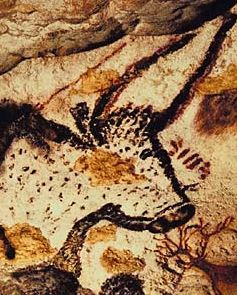Tuesday, September 28th, 2010
Glowing Prehistoric Horns
It’s always interesting to see what knowledge spews from the depths of my brain during lecture. Yesterday, while lecturing on cave paintings, I found myself telling the class about a theory I hadn’t thought about for years.
Back when I was an undergraduate, one of my professors explained a theory about why bulls were important to the prehistoric people (and they were obviously important, since bulls are depicted in so many prehistoric caves. This example on the left comes from Lascaux Cave in France (c. 15,000 BCE)).
The theory presented by my professor revolves around the St. Elmo’s Fire phenomenon. Basically, sometimes during electrical weather storms (i.e. storms with thunder and lightning), the tip of a bull’s horns can have a soft glow. The glow often is accompanied with a hissing or crackling sound.
It is thought that this phenomenon would have impressed prehistoric people, which may account for the supposed veneration of the bull. It could have been seen as a mystical creature with supernatural powers, since its horns had the ability to glow.

I had NO idea bull's horns can glow. That's amazing and it does make so much sense as to why they'd be considered such important animals.
How's this new semester going so far? Your students are lucky to have you!
Does St. Elmo's Fire really happen that much? I'm sure it is impressive, and it's very cool that they depicted it, but I think reason behind the bulls being depicted is probably more complex. Theories like that make prehistoric art seem really simplistic and child-like, no?
Also, how to explain the depictions of other animals, then?
An interesting theory, certainly…
But when I were to draw an animal with glowing horns, I thing I would like to use one of those lovely ochers, or at least something brighter than blackest-of-all-blacks: charcoal.
But maybe I'm wrong, I'm not that into prehistoric caves…
Thanks for your lovely blog,
Arjan
M:
I see you start your Art history course from the very beginning. Personally, I would love to see you post the subject of each lecture you give along with a brief synopsis. I would especially like to know which works you single out for discussion.
Frank
The new quarter is going well, e. My students are great, and I'm having a lot of fun. The glowing theory is interesting, huh?
heidenkind: I don't think the St. Elmo's Fire happens a lot (and I have no idea how many thunderstorms existed in prehistoric Europe), but I'm sure it's impressive too. I can see what you're saying about how this theory makes prehistoric art seem more simplistic. Personally, though, I think this could just be one of the many reasons why bulls were depicted in caves. And the same goes for other animals: there could be multiple reasons for why each animal (or each type of animal) was chosen to be included in a cave painting. I wish we knew more. I'm continually baffled about how we are still in the early stages of understanding cave paintings. We've only known about cave paintings for about 140 years (when Altamira Cave was discovered in the 1870s). That's not very long at all, considering that these paintings are tens of thousands of years old! I wonder how much scholarship will even change during the course of our lives.
Arjan, thanks for your comment! You have a really great point about the color of the horns. I don't know of any horns that are decorated with red ocher, but that would better support the St. Elmo's Fire idea better.
Dr. F: Thanks for the suggestion! I started to write introductory posts a last year (you can see a few on the "introductory/survey" label on my home page). I'll try to add more of these posts. (I can tell you, though, that my posts often correspond with what I am teaching in one way or another; I tend to blog about whatever is currently on my mind.)
Reading this made me think of a lot of indigenous rock art I've seen. It is not unusual for people and animals to be depicted with elaborate "head gear". Conventional wisdom holds these are the auras of creatures and people with special supernatural powers, just as halos of Jesus and the saints are in Christian art. It wouldn't have been necessary for the "artist" to have seen St. Elmo's fire, although it certainly would have made an impression and reinforced the beliefs.